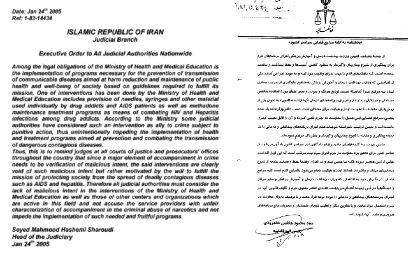Publications
The case delves into the history of malaria control efforts in Zambia, including control and treatment policy changes in the in the early 2000s that set Zambia apart from other countries. Because by 2005 Zambia was still falling short of its targets, the National Malaria Control Center (NMCC) resolved to intensify its efforts by developing one national plan to improve coordination, data collection, partner involvement, and ultimately, rapidly scale-up interventions to meet the national malaria targets. The new NMCC director, Dr. Elizabeth Chizema, helped the program achieve success through several key interventions described in the case. With improved monitoring and evaluation, Chizema could demonstrate progress in malaria control, but she worried that partners might lose interest in helping Zambia given the low burden, and the program still had many challenges to overcome. This is a condensed version of the case Malaria Control in Zambia.
Teaching Note available through Harvard Business Publishing.
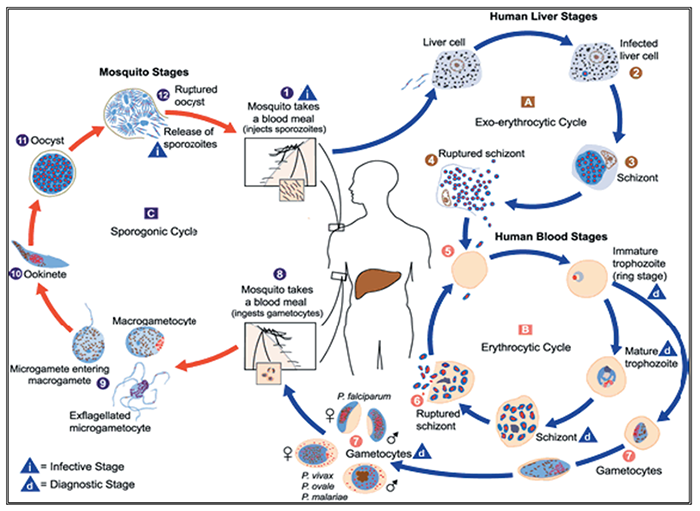
Learning Objectives: To understand the development of a successful malaria control program over time and the components that led to its success including the value of setting bold national goals, the merits of a health system with centralized governance and decentralized implementation, the importance of multiple coordinated interventions as opposed to a "silver bullet" approach for malaria control, and the use of data as an outcome measure, planning tool, and fundraising tool.
Supporting Content: This is a condensed version of the case Malaria Control in Zambia.
Keywords: National strategy, supply chain management, malaria eradication and control, leadership
This case reviews the changes in national policy and the subsequent interventions used to reduce the incidence of malaria in Zambia from 2005 to 2010. After providing contextual information on Zambia-including historical, demographic, social, and health information-the case delves into the history of malaria control efforts worldwide and in Zambia. Though Zambia was at the forefront of malaria control-changing policy, adopting new treatment, and aggressively pursuing comprehensive malaria control efforts-in the early 2000s, by 2005 the Zambian government was still falling short of its targets. The National Malaria Control Center (NMCC) resolved to intensify its efforts by developing one national plan to improve coordination, data collection, and partner involvement, and ultimately, to scale up interventions rapidly in order to meet the national malaria targets. The new NMCC director, Dr. Elizabeth Chizema, guided the program toward success through several key interventions described in the case. With basic improvements in monitoring and evaluation, Chizema could demonstrate progress in malaria control. Nonetheless, she worried that partners might lose interest in helping Zambia given the decreasing burden even though the program still had many challenges to overcome.
Teaching Note available through Harvard Business Publishing.

Learning Objectives: To understand the development of a successful malaria control program over time and the components that led to its success, including the value of setting bold national goals, the merits of a health system with centralized governance and decentralized implementation, the importance of multiple coordinated interventions as opposed to a "silver bullet" approach for malaria control, and the use of data as an outcome measure, planning tool, and fundraising tool.
Supporting Content: There is a shorter version of this case titled Malaria Control in Zambia (Condensed Version).
Keywords: National strategy, supply chain management, malaria eradication and control, leadership
After outlining the history of malaria in Swaziland, this focused case study examines the implementation of rapid diagnostic tests (RDTs) for malaria in Swaziland to improve case management and to strengthen the national malaria surveillance system as the National Malaria Control Program (NMCP) aims to implement a national elimination strategy. In addition to information on RDT selection, the case details Swaziland's quality assurance program-the first of its kind in the region, the public health benefits of the immediate disease notification system for active case detection, and Simon Kunene's leadership qualities as the manager of the NMCP for 24 years. The case addresses the necessary increases in financing and human resources to support the strategy and evaluates the impact of RDTs on the strategy. Challenges the NMCP faces in achieving malaria elimination include sustaining political will, interest, and financial commitments from donors and strengthening health workforce training and RDT procurement and distribution.
Teaching Note available through Harvard Business Publishing.
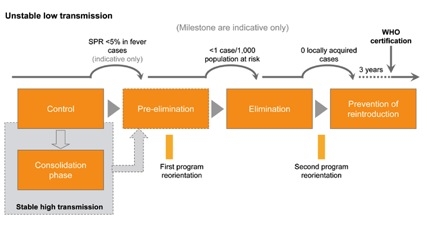
Milestones toward Malaria Elimination. Source: The Global Malaria Action Plan: For a malaria-free world. Roll Back Malaria Partnership, 2008. (Exhibit 4 from "Roll-Out of Rapid Diagnostic Tests for Malaria in Swaziland" case.
Learning Objectives: To understand the role of diagnostics in a malaria elimination strategy, what it takes to effectively integrate a new diagnostic into care delivery, how leaders generate social and political capital over time, and the intricacies of managing a national disease program.
Keywords: National strategy, supply chain management, diagnostic testing strategies, malaria eradication and control
Thailand’s 100% Condom Program, which was implemented nationwide in 1991, is widely credited with averting a generalized HIV epidemic in that nation. This case traces the development and implementation of Thailand’s 100% Condom Program including its conception, the development of a pilot program in one province, and the program’s early regional expansion. It frames these events within the country’s general political, economic, and health situation; the epidemiology and public perception of HIV/AIDS; the government’s early HIV policy; and the economics of the commercial sex industry. The case explores how public health interventions are designed, refined, and spread. The case ends in early 1991 with the program’s founder trying to find ways to spread the successful regional program nationwide.
Teaching Note available through Harvard Business Publishing.

Sex establishments in Patpong Area, including go-go bars and members clubs. Source: "HIV in Thailand: The 100% Condom Program" case.
Learning Objectives: To understand the principles behind the design of disease prevention programs and to examine how successful programs align incentives among various stakeholders to achieve their objectives.
Supporting Content: This case has a supplementary summary of history and next steps, titled The 100% Condom Program: Part B.
Keywords: HIV prevention, stakeholder alignment, harm reduction
This document supplements HIV in Thailand: the 100% Condom Program and recounts the eventual nationwide adoption of that program and its impact on HIV in Thailand.
Teaching Note available through Harvard Business Publishing.
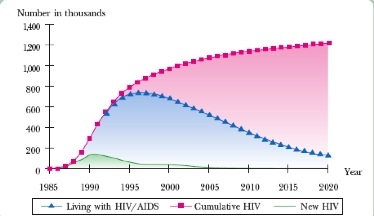
HIV and AIDS Projections, 1985-2020. Source: Department of Disease Control, Ministry of Health (projections based on data up to 2003). (Exhibit 6 from the "HIV in Thailand: The 100% Condom Program" case.)
Learning Objectives: To examine the national spread of a regional disease prevention program and evaluate its impact.
Supporting Content: This document supplements HIV in Thailand: the 100% Condom Program.
Keywords: HIV prevention, stakeholder alignment, harm reduction
This case traces the development of the Academic Model for the Prevention and Treatment of HIV/AIDS (AMPATH), and its founding organization, the Indiana University – Moi University (IU-MU) Partnership in Eldoret, Kenya. The case opens with a discussion of AMPATH’s new Home-Based Counseling and Testing Program (HCT) and its prospects for improving HIV care in Western Kenya. After providing some background on the general political, economic, and health situation in Kenya, it follows the development of the IU-MU Partnership from 1990 to 2000, its subsequent entry into HIV care services through AMPATH in 2001, and AMPATH’s rapid growth to become the largest provider of HIV services in Kenya. It then describes the organizational and operational characteristics of AMPATH and concludes with the organization wrestling with the opportunities and operational challenges that HCT presents.
Teaching Note available through Harvard Business Publishing.

AMPATH Center in Eldoret, Kenya. Source: Case writer. (Exhibit 12 in "The Academic Model for the Prevention and Treatment of HIV/AIDS " case.)
Learning Objectives: To understand the development and design of a large scale HIV care program in a resource-limited setting and to examine how HIV treatment programs can effectively configure their services to provide maximum value to the populations they serve.
Keywords: Service expansion, the role of academic medical centers, HIV treatment and prevention, home-based counseling and treatment
This case reviews the policy changes in tobacco control in post-apartheid South Africa from 1994 to 1996 under the leadership of Minister of Health Dr. Nkosazana Zuma. After providing contextual information on South Africa, including historical, demographic, social, and health information, the case delves into the history of tobacco and of global tobacco control efforts. The case then details the history of tobacco in South Africa, including data collection, epidemiology, early control efforts, and the policy efforts of the mid-1990s. The case describes the African National Congress (ANC)’s policy victories under Zuma’s leadership. Knowing that tobacco disproportionately affected certain racial and minority groups, Zuma made tobacco control a top priority. With the support of the President, local tobacco experts, and anti-tobacco advocates, Zuma worked hard to break previous connections between the government and the tobacco industry and to reduce smoking. The case ends in 1996 when smoking prevalence had declined to 32% from 34% in 1995, but South Africa still had one of the highest levels in the developing world. As the ANC was preparing to enact the new Constitution that reinforced health promotion, Zuma had to determine what her next move would be for tobacco control and how she would prioritize it with the other health needs of the country.
Teaching Note available through Harvard Business Publishing.
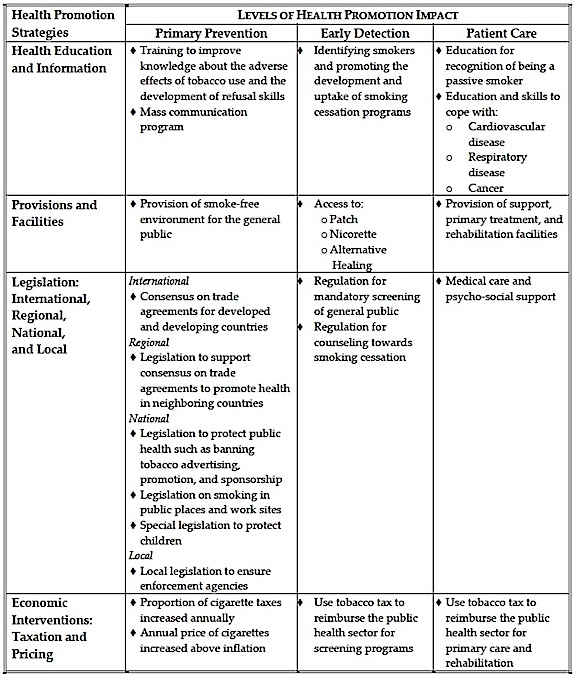
Tobacco Control as Health Promotion. Source: Reddy, SP and Swart D. Unraveling Health Promotion: A Framework for Action: Tobacco Control. MRC: 1998. (Exhibit 8 in "Tobacco Control in South Africa" case.)
Learning Objectives: To understand the political and economic forces that impact tobacco control legislation in a country undergoing an epidemiological shift, the role of research and data, and the value of health communication, chronic disease prevention, and advocacy in health care delivery.
Supporting Content: This case has a supplementary summary of history and next steps, titled Tobacco Control in South Africa: Next Steps.
Keywords: Chronic disease prevention, advocacy, health policy, tobacco control
This case is a supplement to Tobacco Control in South Africa, which reviews the policy changes in tobacco control in post-apartheid South Africa from 1994 to 1996 under the leadership of Minister of Health Dr. Nkosazana Zuma. This case explains what happened after 1996, the steps Zuma took to continue her fight against tobacco (including expanding research capacity, getting increases in excise taxes passed, and pushing national legislation through) and what happened after her departure in 1999.
Teaching Note available through Harvard Business Publishing.
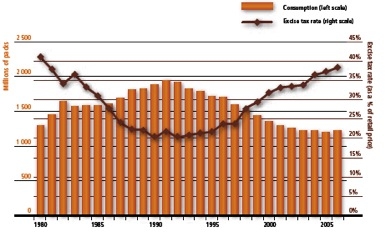
Relationship between Excise Tax Rate and Cigarette Consumption in South Africa. Source: van Walbeek C, WHO. Tobacco Excise Taxation in South Africa. (Exhibit 2 in "Tobacco Control in South Africa: Next Steps" case.)
Learning Objectives: To understand the political and economic forces and the role of research and data in implementing tobacco control legislation in a country undergoing an epidemiological shift, and the value of health communication, chronic disease prevention, and advocacy in health care delivery.
Supporting Content: This case is the supplement to Tobacco Control in South Africa.
Keywords: Chronic disease prevention, advocacy, health policy, tobacco control
This case describes the strategy of the nongovernmental organization (NGO), loveLife, to prevent HIV among South African youth in the face of the world’s largest HIV epidemic, youth culture in post-apartheid South African, and a national government hostile to HIV/AIDS programs. The case traces loveLife from its inception and rapid scale up in 1999 to 2005, when loveLife lost one-third of its operating budget after the Global Fund to Fight AIDS, Tuberculosis and Malaria (Global Fund) chose not to renew its second phase of funding. This case documents loveLife’s strategy in scaling up and sustaining delivery of HIV prevention services at scale. A short, optional case coda describes loveLife’s restructuring and positioning after the Global Fund crisis up to 2009.
Teaching Note available through Harvard Business Publishing.
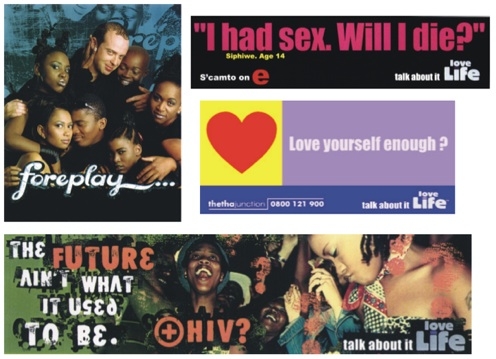
Examples of loveLife media. Source: loveLife. (Exhibit 10 from "loveLife: Preventing HIV Among South African Youth" case.)
Learning Objectives: To learn the application of strategic thinking in HIV prevention using Michael Porter’s “Five Tests of a Good Strategy” and to understand the organizational changes required in transitioning from scaling up to operating at scale.
Supporting Content: This case has a supplementary summary of history and next steps titled loveLife: preventing HIV among South African youth (Part B). There is also an additional sequel, loveLife: Transitions After 2005.
Keywords: Demand generation, scale up, sustaining delivery at scale, HIV prevention among youth, strategy, stigma
This case describes the strategy of the nongovernmental organization (NGO), loveLife, to prevent HIV among South African youth in the face of the world’s largest HIV epidemic, youth culture in post-apartheid South African, and a national government hostile to HIV/AIDS programs. The case traces loveLife from its inception and rapid scale up in 1999 to 2005, when loveLife lost one-third of its operating budget after the Global Fund to Fight AIDS, Tuberculosis and Malaria (Global Fund) chose not to renew its second phase of funding. This case documents loveLife’s strategy in scaling up and sustaining delivery of HIV prevention services at scale. A short, optional case coda describes loveLife’s restructuring and positioning after the Global Fund crisis up to 2009.
Teaching Note available through Harvard Business Publishing.
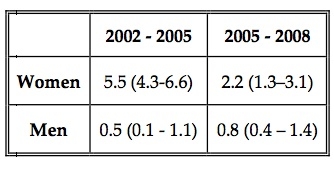
HIV Incidence among 15-20-year-old South Africans, 2002-2008. Source: Rehle T, Hallett T, Shisana O, et al. A Decline in New HIV Infections in South Africa: Estimating HIV Incidence from Three National HIV Surveys in 2002, 2005 and 2008. PloS one. 2010;5(6):e11094. (Exhibit 2 from "loveLife: preventing HIV among South African youth" case.)
Learning Objectives: To learn the application of strategic thinking in HIV prevention using Michael Porter’s “Five Tests of a Good Strategy” and to understand the organizational changes required in transitioning from scaling up to operating at scale.
Supporting Content: This case is the supplement to loveLife: Preventing HIV Among South African Youth.
Keywords: Demand generation, scale up, sustaining delivery at scale, HIV prevention among youth, strategy, stigma
This case is the second in a two-part series describing the Avahan Indian AIDS Initiative (Avahan), a large-scale HIV prevention delivery program of the Bill & Melinda Gates Foundation (Gates Foundation). The case examines Avahan's choice of intervention strategies in the face of the HIV epidemic of India in 2002. It describes Avahan's structure, operations, and execution style, as well as how Avahan's management system for its seven "state lead partners" and 137 district-level nongovernmental organizations was applied initially to scale and later to sustain the delivery model. The case ends with Avahan's director planning to transfer program ownership to the Government of India.
Teaching Note available through Harvard Business Publishing.
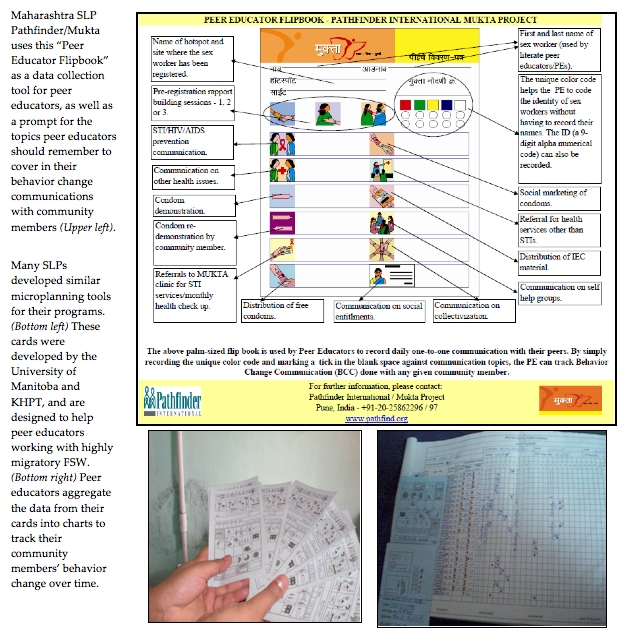
Examples of Microplanning Tools Developed by Avahan SLPs. Source: Created by case writers. (Exhibit 10 "The Avahan India AIDS Initiative: Managing Targeted HIV Prevention at Scale" case.)
Learning Objectives: To understand the strategies needed to deliver HIV prevention services at scale; how the configuration of management activities can enable rapid scale up of HIV prevention programming; and how these management activities must evolve to sustain delivery at scale.
Keywords: Management and operations, HIV prevention, transferring large-scale programs to government ownership, scaling up, sustainability, strategy
This case examines the potential for a non-governmental organization, Zanmi Lasante/Partners in Health (ZL/PIH), to aid in improving voluntary counseling and testing (VCT) services for HIV at a government hospital in Hinche, Haiti. The events of the case begin when the local government official who oversees the hospital invites ZL/PIH to work with the government to improve the hospital’s VCT services. After providing background information on the history of Haiti, on Hinche, and on the state of the current VCT program, the case describes ZL/PIH’s health care delivery model including its management systems, its use of community health workers, and its social programs. It explains how ZL/PIH adapted its mod
Teaching Note available through Harvard Business Publishing.

Rainy season on the roads, Central Plateau, Haiti; Credit: Evan Lyon
Learning Objectives: To understand how social, economic and political factors influence health care delivery and to examine effective strategies to address these factors in the design of health care programs.
Supporting Content: This case has a supplementary summary of history and next steps, titled Two Years in Hinche.
Keywords: Community-based organizations, HIV prevention, government-NGO partnerships
This case traces the establishment of Botanical Extracts (BE) as a manufacturer of artemisinin, the active pharmaceutical ingredient in artemisinin-based combination therapies (ACTs) for malaria in East Africa. After providing background on the disease and its epidemiology and history, the case delves into the malaria eradication and control efforts of the past 50 years, with emphasis on treatment with anti-malarials. It describes how artemisinin made the transition from a traditional Chinese medicine to Novartis’ largest pharmaceutical product by volume. The case presents background information on the artemisinin industry, with emphasis on the WHO, Novartis, artemisinin extractors, and Artemisia farmers. The case details the founding of BE, its role in the ACT industry, and the complex supply chain for ACTs from the cultivation of the raw material to the delivery of ACTs as well as the public private partnership that was driving the manufacturing and delivery of ACTs. The case ends by describing the challenges faced by BE in June 2008, asking how best the company should move forward.
Teaching Note available through Harvard Business Publishing.

The Artemisia Plant and Cultivation. Image A Source: Advanced Bio-Extracts. Image B Source: Farmer in Central Kenya, June 2008. (Exhibit 7 from "Investing in Global Health: Botanical Extracts Ltd." case.)
Learning Objectives: To understand 1) the challenges of manufacturing necessary healthcare commodities for a populace that is unable to afford them, 2) how risk is distributed among actors in public-private partnerships, and 3) how investment in health commodities in developing countries can promote sustainable economic development.
Keywords: Public-private partnerships, pharmaceutical supply chains, malaria eradication and control, health commodity manufacturing
This case examines the development of a tuberculosis (TB) treatment program in Bangladesh by the non-governmental organization, BRAC, from 1984 to 2006. After providing background about Bangladesh, the burden of TB there, and BRAC, the case examines how this program was piloted and grew to cover a population of 80 million people. It details how BRAC was able to create a TB control program that utilized community health workers to perform most of its essential functions including case finding, directly-observed therapy, identification of complications, and record keeping. The case concludes with a brief summary of BRAC’s expansion to Afghanistan and recently, Africa, and asks the reader to consider the feasibility of this TB care model in other contexts and in other conditions, such as HIV/AIDS.
Teaching Note available through Harvard Business Publishing.

Timeline of BRAC TB Program Expansions. Source: From One to Many: Scaling Up Health Programs in Low-Income Countries. Edited by Richard A Cash, A Mushtaque R. Chowdhury, George B. Smith, and Faruque Ahmed (2010). Ch 13. Islam A and May MA. Decentralized Management in the Expansion of BRAC's Rural Tuberculosis Program (DOTS). Pgs. 207-214. (Exhibit 3 in "BRAC’s Tuberculosis Program: Pioneering DOTS Treatment for TB in Rural Bangladesh" case.)
Learning Objectives: To understand effective strategies for effectively engaging community health workers to deliver complex medical and public health interventions to large populations in low resource settings.
Supporting Content: The sequel to this case is titled Tuberculosis in Dhaka: BRAC’s Urban TB Program.
Keywords: Community health workers, tuberculosis control, rural nongovernmental organizations, social enterprise
This case examines BRAC’s experience expanding its rural TB program to the urban environment of Dhaka between 2002 and 2008. The case provides background information about Dhaka and describes what TB services existed at the time. The case then describes the expansion of BRAC’s TB program into Dhaka and details innovations in the Urban program. Students should gain an understanding of how these program modifications were a response to the specific challenges the program faced in the urban setting. The case allows an exploration of how successful health care delivery program adapt to new environments.
Teaching Note available through Harvard Business Publishing.
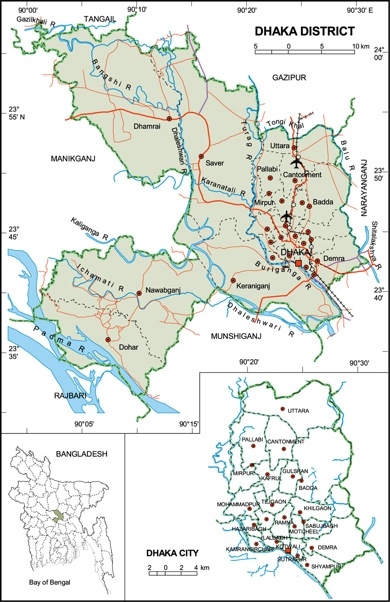
Map of Dhaka. Source: Available at http://www.urpnissues.com/webpage/maps/Districts/13.GIF. (Exhibit 1 in "Tuberculosis in Dhaka: BRAC’s Urban TB Program" case.)
Learning Objectives: To understand how a successful health care delivery program that is uniquely tailored to a particular setting can adapt its operations in a new environment.
Supporting Content: This case is a sequel to BRAC’s Tuberculosis Program: Pioneering DOTS Treatment for TB in Rural Bangladesh.
Keywords: Service delivery innovation, tuberculosis control, urban nongovernmental organizations
This case describes the Brazilian National AIDS Program's strategy in the late 2000s to prevent HIV infections. The case is set against the context of a heterogeneous, concentrated epidemic and decentralized public health system that guaranteed access to care and treatment. The case traces the nation's response to HIV from the late 1980s through 2009 via a human rights framework, highlighting the cooperation with civil society. Readers are challenged to understand the relationships between HIV/AIDS prevention and treatment, decentralization and sustainability.
Teaching Note available through Harvard Business Publishing.
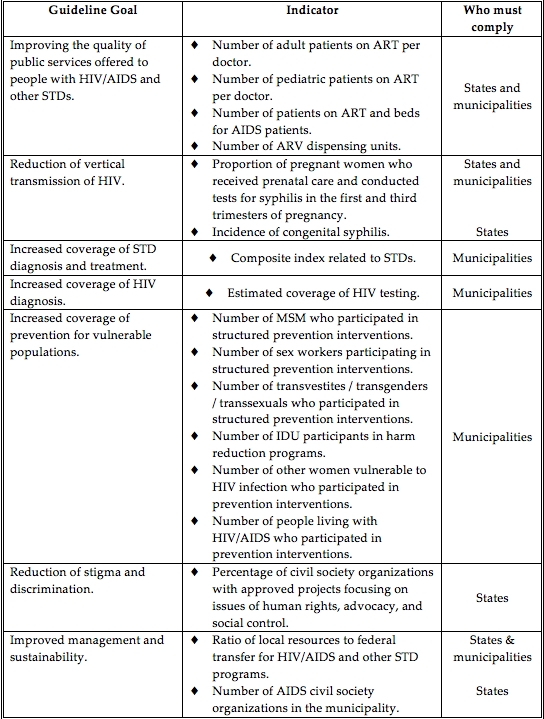
Decentralization Policy M&E Indicators. Source: National Department of STD, AIDS and Viral Hepatitis. (Exhibit 14 from "HIV/AIDS in Brazil: Delivering Prevention in a Decentralized Health System" case.)
Learning Objectives: Students should understand the tradeoffs involved in a decentralized governance structure, the levers a central government department can pull to influence local health care delivery in a decentralized health system, and how civil society advocacy contributes to program sustainability.
Keywords: Human rights, HIV prevention, Sustainability, Role of civil society, Strategy
This case focuses on the establishment of the Olyset® Consortium—a public-private partnership that was created to facilitate the manufacture of long-lasting insecticidal bed nets to prevent malaria infection in sub-Saharan Africa—and A to Z Textile Mills (“A to Z”), the manufacturer of the nets in Arusha, Tanzania. The case examines how the public-private partnership was developed, its use of an incentive-based supply chain, A to Z’s business model and impact, and the sustainability of the venture. The case reveals that despite significant success in attaining objectives, the misaligned incentives of the many partners presented major obstacles to the overall sustainability of A to Z’s Olyset® production line.
Teaching Note available through Harvard Business Publishing.
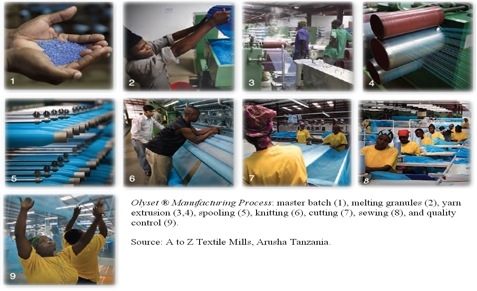
Long Lasting Insecticide Nets and Olyset Production Process. Source: A to Z Textile Mills Ltd., Arusha, Tanzania (Case Exhibit 9).
Learning Objectives: To understand the potential for public-private partnerships to leverage innovation and scalability from the private sector and quality and equitable access from the public sector and to examine the costs and benefits of local manufacturing of technologically complex global health commodities in resource-limited settings.
Keywords: Public-private partnerships, incentive-based supply chain, global health commodity manufacturing, malaria prevention
This case documents Indonesia’s progress in developing a coordinated national HIV/AIDS response. Within the context of a new democratic government, a weak civil society sector, a newly decentralized and underfunded public health system, and a religiously conservative environment, the case describes how international donors financed and directed HIV/AIDS-related efforts for the first 15 years of the epidemic. In 2006 the National AIDS Commission (NAC) was restructured and awarded funding from the United Kingdom’s Department for International Development (DFID). The case documents how DFID’s flexible financing enabled the NAC to develop a single national strategy, a national monitoring and evaluation framework, and a system of local AIDS commissions. The case ends in 2009 with the NAC preparing to assume a new role as one of three Principal Recipients of the Global Fund to Fight, AIDS, Tuberculosis and Malaria. The NAC leadership must contemplate how to sustain and further the progress made in scaling up HIV prevention services while taking on new responsibilities as a Global Fund Principal Recipient.
Teaching Note available through Harvard Business Publishing.
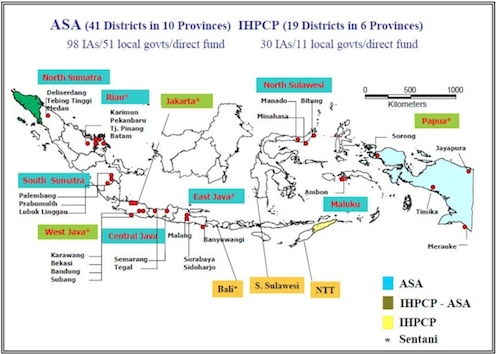
Map of Indonesia Showing HIV Program Implementers, 2005. Source: Indonesia National AIDS Commission. (Exhibit 1 "HIV/AIDS in Indonesia: Building a Coordinated National Response" case.)
Learning Objectives: To understand the impact of external financing, donor-driven agendas, and a national champion in creating a multisectoral response to HIV in a religiously conservative, lower middle-income country.
Keywords: National strategy, sustainability, HIV prevention, flexible donor financing
This case traces the development and implementation of Iran’s Triangular Clinic, an innovative health care delivery program, from its beginning as a site for counseling HIV-infected individuals to an integrated facility offering comprehensive HIV, sexually transmitted disease (STD), and drug addiction treatment, care, and support. The case examines the need for such services among the marginalized population that the first clinic served within the historical, political, economic, and health context of Iran and, specifically, in Kermanshah province, where the project begins. The case raises the question of how the clinic model might be integrated into primary health care and replicated throughout the country as part of the Iranian Ministry of Health’s Integrated Health Program.
Teaching Note available through Harvard Business Publishing.
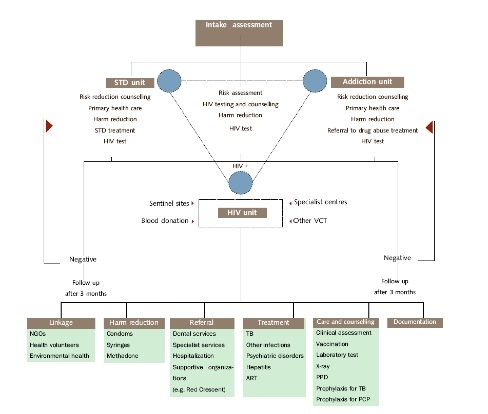
Triangular clinic model. Source: World Health Organization and Regional Office for the Eastern Mediterranean, Best Practice in HIV/AIDS Prevention and Care for Drug Abusers: The Triangular Clinic in Kermanshah, Islamic Republic of Iran 2004, WHO: Cairo.
Learning Objectives: To examine how health care delivery organizations can configure their services to deliver high value health care to the populations they serve and to understand methods to engage marginalized populations in order to increase their access to and demand for health services.
Supporting Content: The sequel to this case is titled Scaling up Iran's Triangular Clinic.
Keywords: Marginalized populations, comprehensive HIV prevention, harm reduction
